Abstract
Behavioral end points are being used with greater frequency in neurotoxicology to detect and characterize the adverse effects of chemicals on the nervous system. Behavioral measures are particularly important for neurotoxicity risk assessment since many known neurotoxicants do not result in neuropathology. The chlorinated hydrocarbon class consists of a wide variety of chemicals including polychlorinated biphenyls, clioquinol, trichloroethylene, hexachlorophene, organochlorine insecticides (DDT, dicofol, chlordecone,dieldrin, and lindane), and phenoxyherbicides. Each of these chemicals has effects on motor, sensory, or cognitive function that are detectable using functional measures such as behavior. Furthermore, there is evidence that if exposure occurs during critical periods of development, many of the chlorinated hydrocarbons are developmental neurotoxicants. Developmental neurotoxicity is frequently expressed as alterations in motor function or cognitive abilities or changes in the ontogeny of sensorimotor reflexes. Neurotoxicity risk assessment should include assessments of the full range of possible neurotoxicological effects, including both structural and functional indicators of neurotoxicity.
Full text
PDF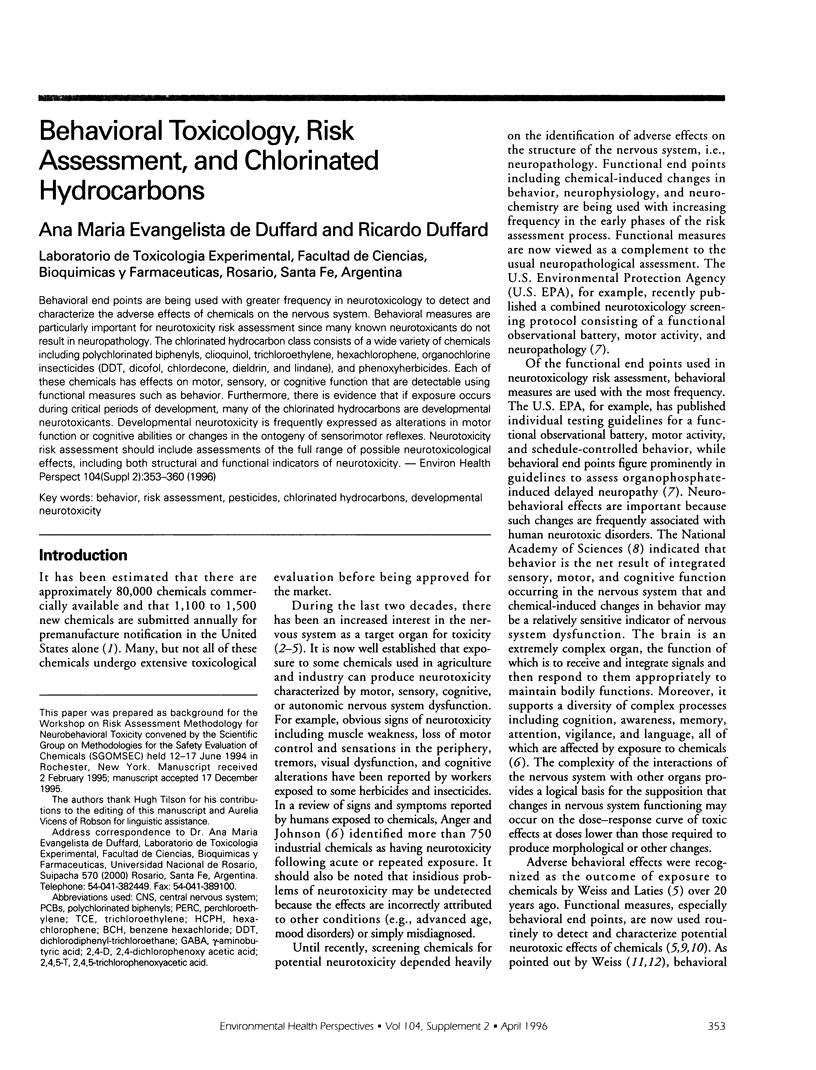
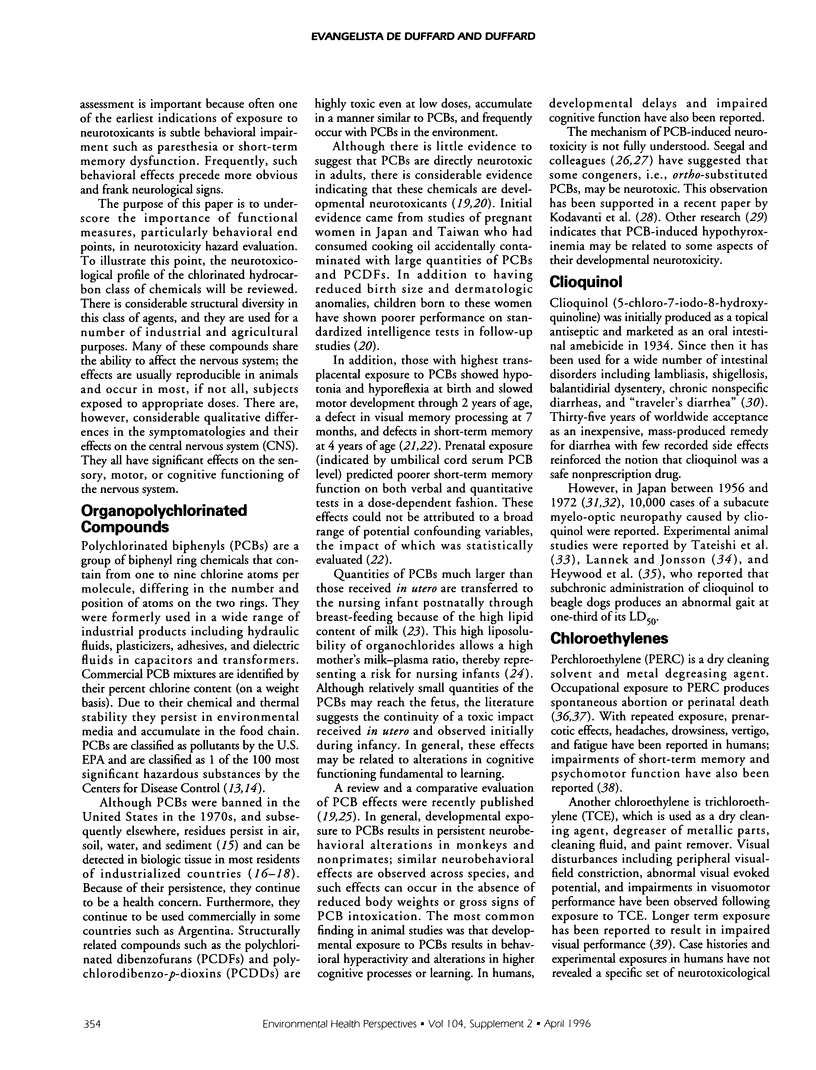
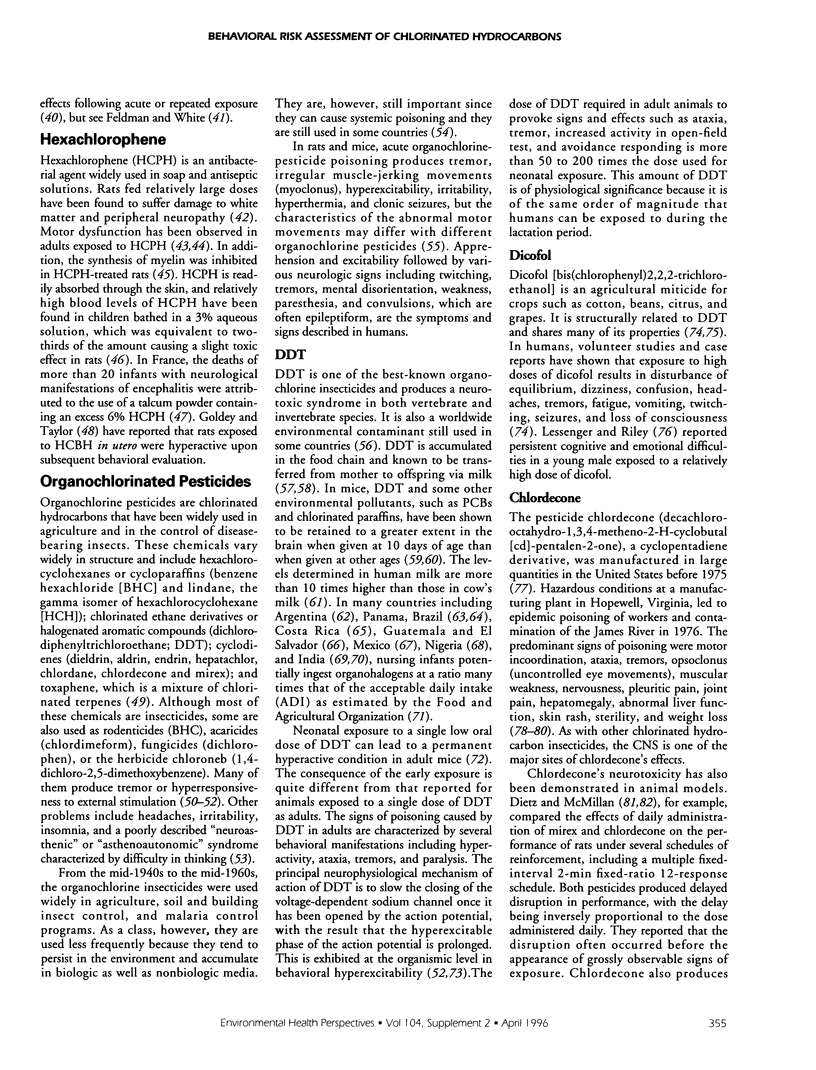
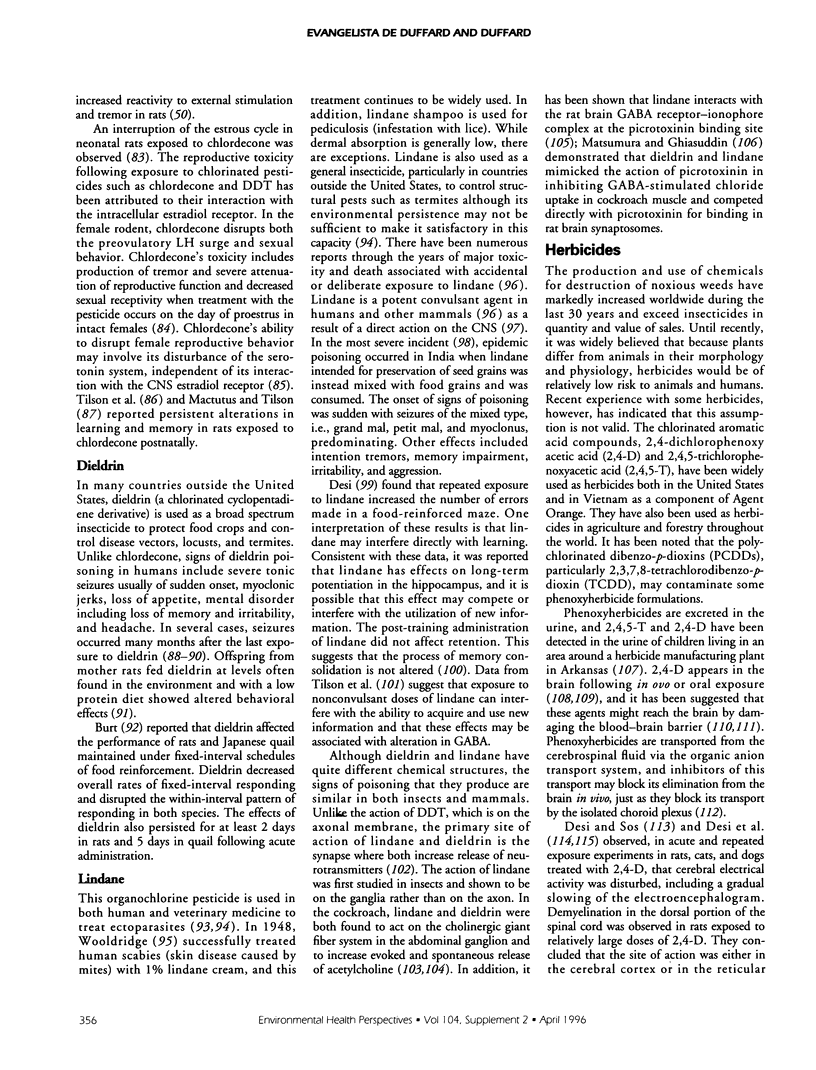
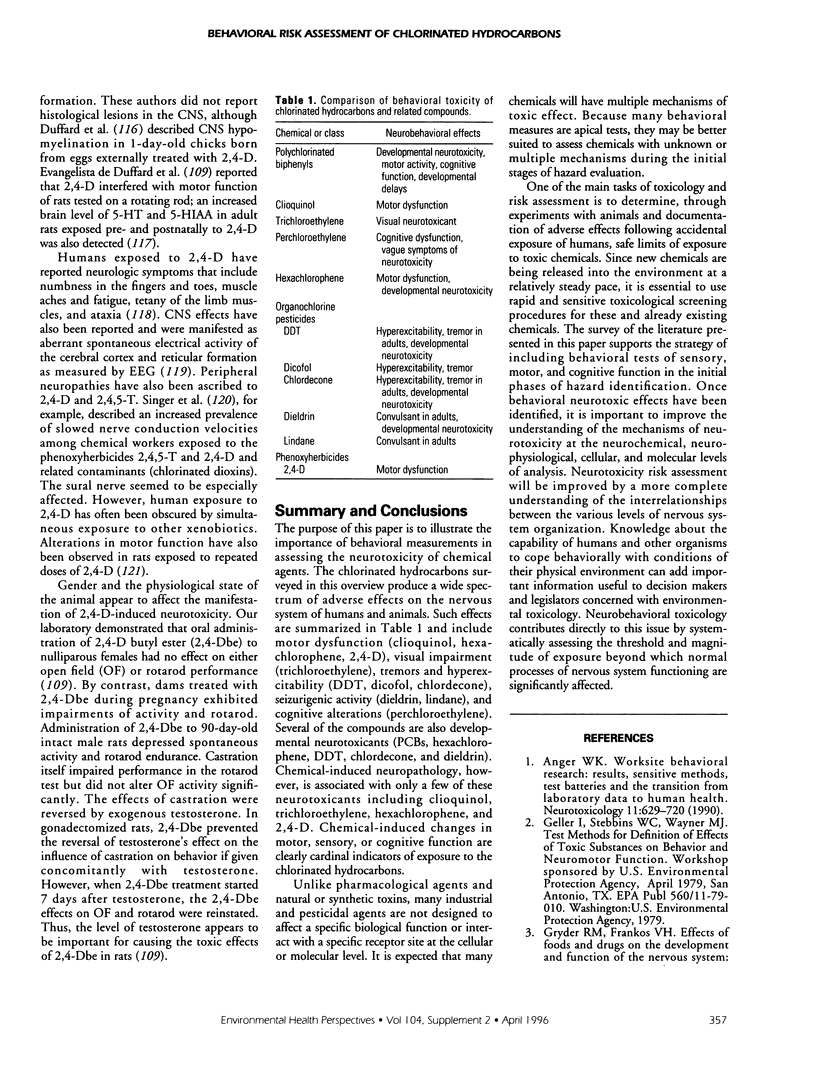
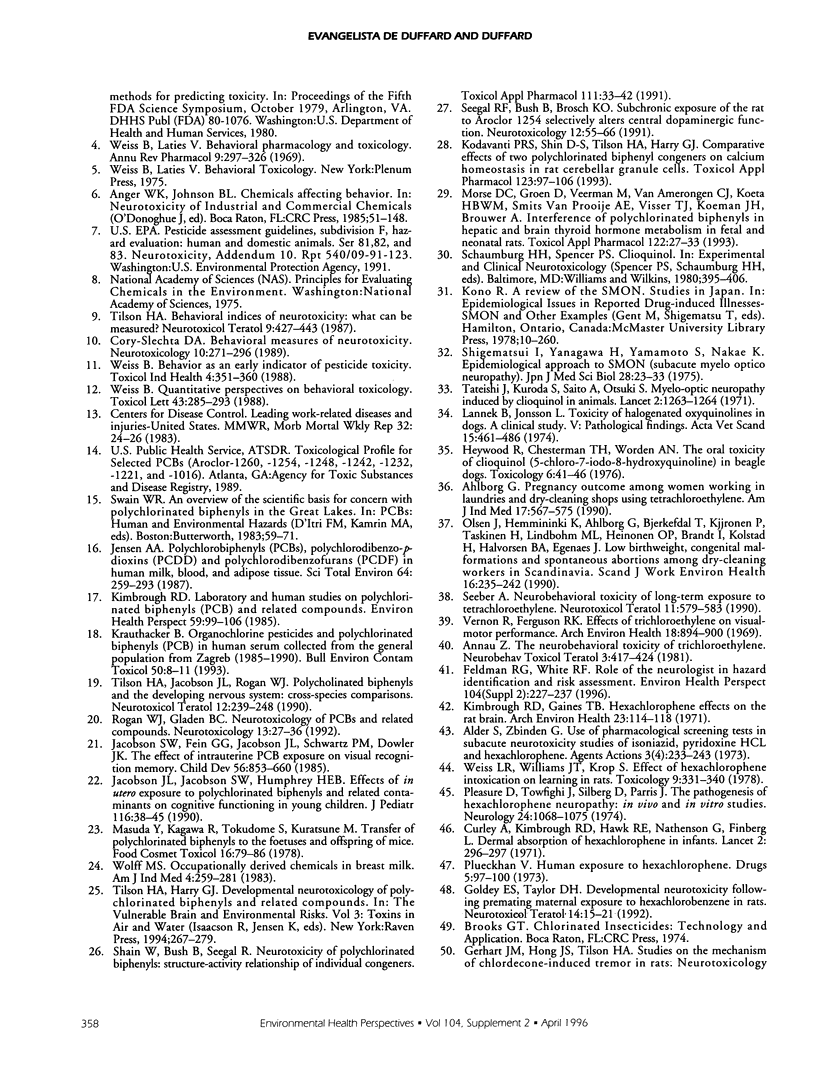
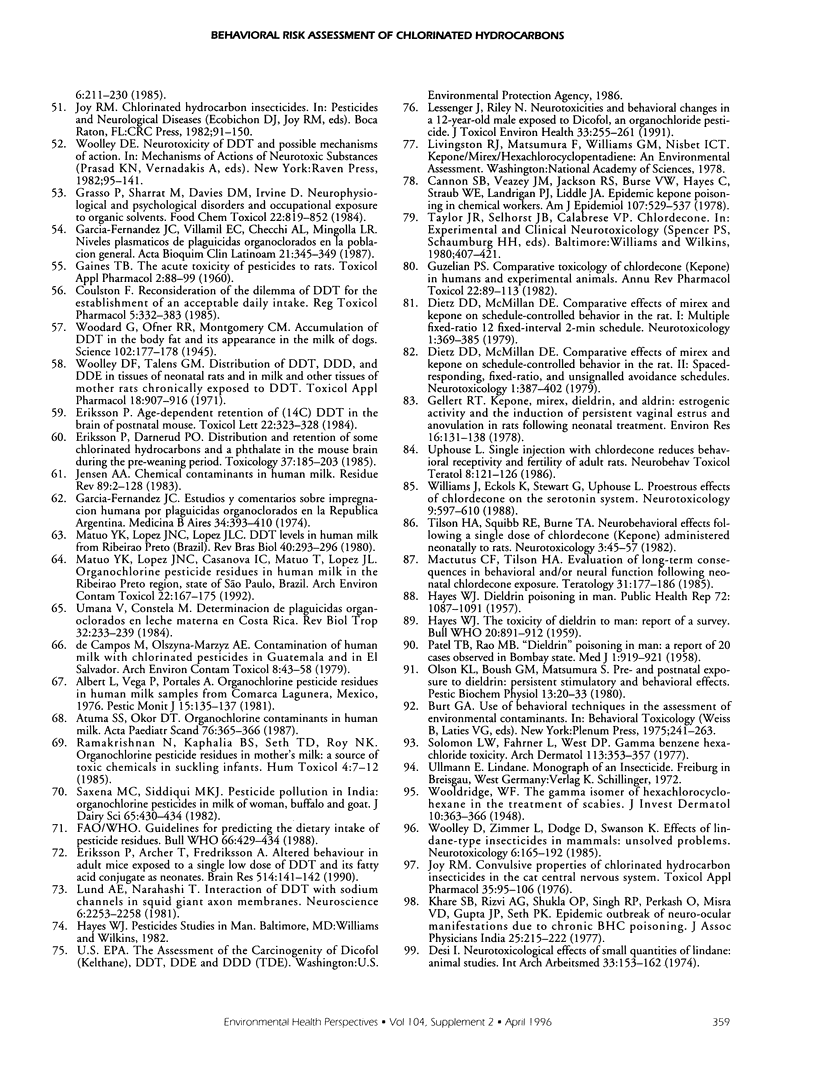
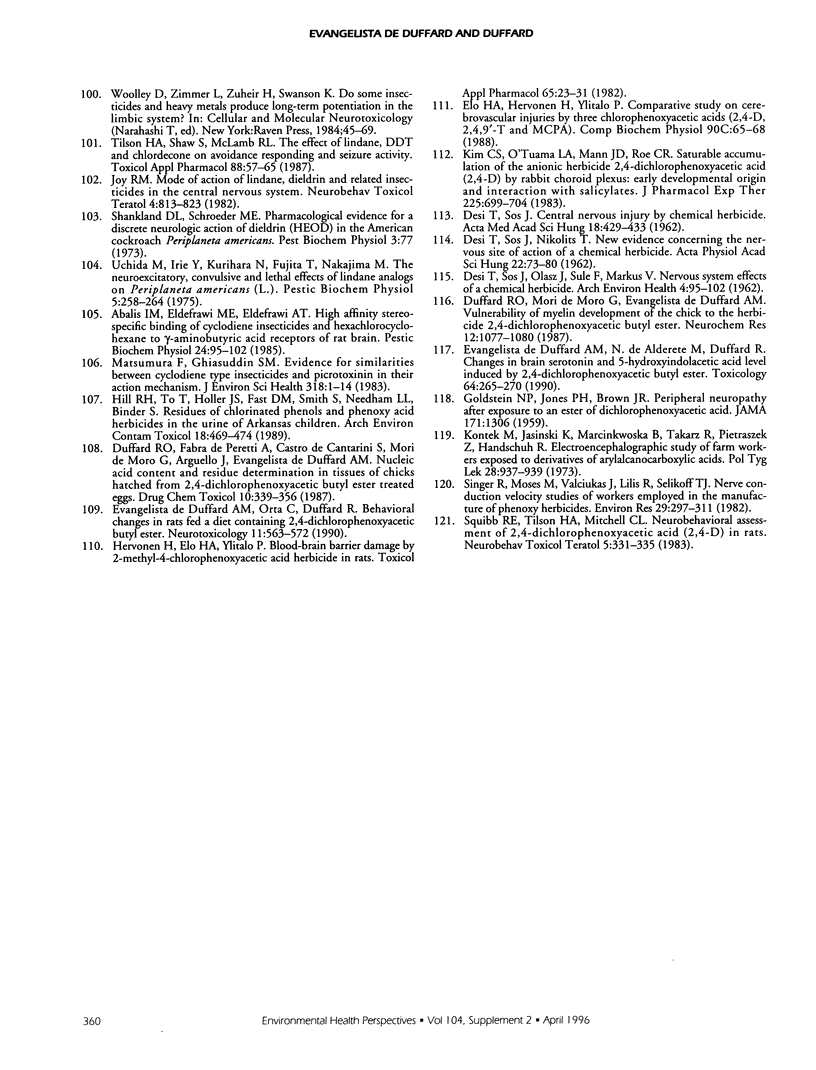
Selected References
These references are in PubMed. This may not be the complete list of references from this article.
- Ahlborg G., Jr Pregnancy outcome among women working in laundries and dry-cleaning shops using tetrachloroethylene. Am J Ind Med. 1990;17(5):567–575. doi: 10.1002/ajim.4700170503. [DOI] [PubMed] [Google Scholar]
- Albert L., Vega P., Portales A. Organochlorine pesticide residues in human milk samples from Comarca Lagunera, Mexico, 1976. Pestic Monit J. 1981 Dec;15(3):135–138. [PubMed] [Google Scholar]
- Alder S., Zbinden G. Use of pharmacological screening tests in subacute neurotoxicity studies of isoniazid, pyridoxine HCl and hexachlorophene. Agents Actions. 1973 Nov;3(4):233–243. doi: 10.1007/BF01968549. [DOI] [PubMed] [Google Scholar]
- Annau Z. The neurobehavioral toxicity of trichloroethylene. Neurobehav Toxicol Teratol. 1981 Winter;3(4):417–424. [PubMed] [Google Scholar]
- Atuma S. S., Okor D. I. Organochlorine contaminants in human milk. Acta Paediatr Scand. 1987 Mar;76(2):365–366. doi: 10.1111/j.1651-2227.1987.tb10480.x. [DOI] [PubMed] [Google Scholar]
- Cannon S. B., Veazey J. M., Jr, Jackson R. S., Burse V. W., Hayes C., Straub W. E., Landrigan P. J., Liddle J. A. Epidemic kepone poisoning in chemical workers. Am J Epidemiol. 1978 Jun;107(6):529–537. doi: 10.1093/oxfordjournals.aje.a112572. [DOI] [PubMed] [Google Scholar]
- Cory-Slechta D. A. Behavioral measures of neurotoxicity. Neurotoxicology. 1989 Summer;10(2):271–295. [PubMed] [Google Scholar]
- Coulston F. Reconsideration of the dilemma of DDT for the establishment of an acceptable daily intake. Regul Toxicol Pharmacol. 1985 Dec;5(4):332–383. doi: 10.1016/0273-2300(85)90002-9. [DOI] [PubMed] [Google Scholar]
- Curley A., Kimbrough R. D., Hawk R. E., Nathenson G., Finberg L. Dermal absorption of hexochlorophane in infants. Lancet. 1971 Aug 7;2(7719):296–297. doi: 10.1016/s0140-6736(71)91337-7. [DOI] [PubMed] [Google Scholar]
- DESI I., SOS J. Central nervous injury by a chemical herbicide. Acta Med Acad Sci Hung. 1962;18:429–433. [PubMed] [Google Scholar]
- DESI I., SOS J., NIKOLITS I. New evidence concerning the nervous site of action of a chemical herbicide causing professional intoxication. Acta Physiol Acad Sci Hung. 1962;22:73–80. [PubMed] [Google Scholar]
- DESI I., SOS J., OLASZ J., SULE F., MARKUS V. Nervous system effects of a chemical herbicide. Arch Environ Health. 1962 Jan;4:95–102. doi: 10.1080/00039896.1962.10663121. [DOI] [PubMed] [Google Scholar]
- Duffard R. O., Fabra de Peretti A. I., Castro de Cantarini S. M., Mori de Moro G. B., Argüello J. M., Evangelista de Duffard A. M. Nucleic acid content and residue determination in tissues of chicks born from 2,4-dichlorophenoxyacetic butyl ester treated eggs. Drug Chem Toxicol. 1987;10(3-4):339–355. doi: 10.3109/01480548709042991. [DOI] [PubMed] [Google Scholar]
- Duffard R. O., Mori de Moro G. B., Evangelista de Duffard A. M. Vulnerability of myelin development of the chick to the herbicide 2,4-Dichlorophenoxyacetic butyl ester. Neurochem Res. 1987 Dec;12(12):1077–1080. doi: 10.1007/BF00971707. [DOI] [PubMed] [Google Scholar]
- Dési I. Neurotoxicological effect of small quantities of lindane. Animal studies. Int Arch Arbeitsmed. 1974;33(2):153–162. doi: 10.1007/BF00538999. [DOI] [PubMed] [Google Scholar]
- Elo H. A., Hervonen H., Ylitalo P. Comparative study on cerebrovascular injuries by three chlorophenoxyacetic acids (2,4-D, 2,4,5-T and MCPA). Comp Biochem Physiol C. 1988;90(1):65–68. doi: 10.1016/0742-8413(88)90098-9. [DOI] [PubMed] [Google Scholar]
- Eriksson P. Age-dependent retention of [14C]DDT in the brain of the postnatal mouse. Toxicol Lett. 1984 Sep;22(3):323–328. doi: 10.1016/0378-4274(84)90108-5. [DOI] [PubMed] [Google Scholar]
- Eriksson P., Archer T., Fredriksson A. Altered behaviour in adult mice exposed to a single low dose of DDT and its fatty acid conjugate as neonates. Brain Res. 1990 Apr 23;514(1):141–142. doi: 10.1016/0006-8993(90)90446-i. [DOI] [PubMed] [Google Scholar]
- Eriksson P., Darnerud P. O. Distribution and retention of some chlorinated hydrocarbons and a phthalate in the mouse brain during the pre-weaning period. Toxicology. 1985 Dec;37(3-4):189–203. doi: 10.1016/0300-483x(85)90082-4. [DOI] [PubMed] [Google Scholar]
- Evangelista de Duffard A. M., Orta C., Duffard R. Behavioral changes in rats fed a diet containing 2,4-dichlorophenoxyacetic butyl ester. Neurotoxicology. 1990 Winter;11(4):563–572. [PubMed] [Google Scholar]
- Feldman R. G., White R. F. Role of the neurologist in hazard identification and risk assessment. Environ Health Perspect. 1996 Apr;104 (Suppl 2):227–237. doi: 10.1289/ehp.96104s2227. [DOI] [PMC free article] [PubMed] [Google Scholar]
- GAINES T. B. The acute toxicity of pesticides to rats. Toxicol Appl Pharmacol. 1960 Jan;2:88–99. doi: 10.1016/0041-008x(60)90074-0. [DOI] [PubMed] [Google Scholar]
- GOLDSTEIN N. P., JONES P. H., BROWN J. R. Peripheral neuropathy after exposure to an ester of dichlorophenoxyacetic acid. J Am Med Assoc. 1959 Nov 7;171:1306–1309. doi: 10.1001/jama.1959.03010280030007. [DOI] [PubMed] [Google Scholar]
- Garcia Fernandez J. C. Estudios y comentarios sobre impregnación humana por plaguidicas organoclorados en la república argentina. Medicina (B Aires) 1974 Jul-Aug;34(4):393–410. [PubMed] [Google Scholar]
- Gellert R. J. Kepone, mirex, dieldrin, and aldrin: estrogenic activity and the induction of persistent vaginal estrus and anovulation in rats following neonatal treatment. Environ Res. 1978 Jul;16(1-3):131–138. doi: 10.1016/0013-9351(78)90150-0. [DOI] [PubMed] [Google Scholar]
- Goldey E. S., Taylor D. H. Developmental neurotoxicity following premating maternal exposure to hexachlorobenzene in rats. Neurotoxicol Teratol. 1992 Jan-Feb;14(1):15–21. doi: 10.1016/0892-0362(92)90024-5. [DOI] [PubMed] [Google Scholar]
- Grasso P., Sharratt M., Davies D. M., Irvine D. Neurophysiological and psychological disorders and occupational exposure to organic solvents. Food Chem Toxicol. 1984 Oct;22(10):819–852. doi: 10.1016/0278-6915(84)90121-2. [DOI] [PubMed] [Google Scholar]
- Guzelian P. S. Comparative toxicology of chlordecone (Kepone) in humans and experimental animals. Annu Rev Pharmacol Toxicol. 1982;22:89–113. doi: 10.1146/annurev.pa.22.040182.000513. [DOI] [PubMed] [Google Scholar]
- HAYES W. J., Jr Dieldrin poisoning in man. Public Health Rep. 1957 Dec;72(12):1087–1091. [PMC free article] [PubMed] [Google Scholar]
- HAYES W. J., Jr The toxicity of dieldrin to man: report on a survey. Bull World Health Organ. 1959;20:891–912. [PMC free article] [PubMed] [Google Scholar]
- Hervonen H., Elo H. A., Ylitalo P. Blood-brain barrier damage by 2-methyl-4-chlorophenoxyacetic acid herbicide in rats. Toxicol Appl Pharmacol. 1982 Aug;65(1):23–31. doi: 10.1016/0041-008x(82)90358-1. [DOI] [PubMed] [Google Scholar]
- Heywood R., Chesterman H., Worden A. N. The oral toxicity of clioquinol (5-chloro-7-iodo-8-hydroxyquinoline) in beagle dogs. Toxicology. 1976 Jun;6(1):41–46. doi: 10.1016/0300-483x(76)90006-8. [DOI] [PubMed] [Google Scholar]
- Hill R. H., Jr, To T., Holler J. S., Fast D. M., Smith S. J., Needham L. L., Binder S. Residues of chlorinated phenols and phenoxy acid herbicides in the urine of Arkansas children. Arch Environ Contam Toxicol. 1989 Jul-Aug;18(4):469–474. doi: 10.1007/BF01055011. [DOI] [PubMed] [Google Scholar]
- Jacobson J. L., Jacobson S. W., Humphrey H. E. Effects of in utero exposure to polychlorinated biphenyls and related contaminants on cognitive functioning in young children. J Pediatr. 1990 Jan;116(1):38–45. doi: 10.1016/s0022-3476(05)81642-7. [DOI] [PubMed] [Google Scholar]
- Jacobson S. W., Fein G. G., Jacobson J. L., Schwartz P. M., Dowler J. K. The effect of intrauterine PCB exposure on visual recognition memory. Child Dev. 1985 Aug;56(4):853–860. [PubMed] [Google Scholar]
- Jensen A. A. Chemical contaminants in human milk. Residue Rev. 1983;89:1–128. doi: 10.1007/978-1-4612-5601-4_1. [DOI] [PubMed] [Google Scholar]
- Jensen A. A. Polychlorobiphenyls (PCBs), polychlorodibenzo-p-dioxins (PCDDs) and polychlorodibenzofurans (PCDFs) in human milk, blood and adipose tissue. Sci Total Environ. 1987 Jul;64(3):259–293. doi: 10.1016/0048-9697(87)90250-6. [DOI] [PubMed] [Google Scholar]
- Joy R. M. Convulsive properties of chlorinated hydrocarbon insecticides in the cat central nervous system. Toxicol Appl Pharmacol. 1976 Jan;35(1):95–106. doi: 10.1016/0041-008x(76)90114-9. [DOI] [PubMed] [Google Scholar]
- Joy R. M. Mode of action of lindane, dieldrin and related insecticides in the central nervous system. Neurobehav Toxicol Teratol. 1982 Nov-Dec;4(6):813–823. [PubMed] [Google Scholar]
- Khare S. B., Rizvi A. G., Shukla O. P., Singh R. R., Perkash O., Misra V. D., Gupta J. P., Sethi P. K. Epidemic outbreak of neuro-ocular manifestations due to chronic BHC poisoning. J Assoc Physicians India. 1977 Mar;25(3):215–222. [PubMed] [Google Scholar]
- Kim C. S., O'Tuama L. A., Mann J. D., Roe C. R. Saturable accumulation of the anionic herbicide, 2,4-dichlorophenoxyacetic acid (2,4-D), by rabbit choroid plexus: early developmental origin and interaction with salicylates. J Pharmacol Exp Ther. 1983 Jun;225(3):699–704. [PubMed] [Google Scholar]
- Kimbrough R. D., Gaines T. B. Hexachlorophene effects on the rat brain: study of high doses by light and electron microscopy. Arch Environ Health. 1971 Aug;23(2):114–118. doi: 10.1080/00039896.1971.10665966. [DOI] [PubMed] [Google Scholar]
- Kimbrough R. D. Laboratory and human studies on polychlorinated biphenyls (PCBs) and related compounds. Environ Health Perspect. 1985 Feb;59:99–106. doi: 10.1289/ehp.59-1568093. [DOI] [PMC free article] [PubMed] [Google Scholar]
- Kodavanti P. R., Shin D. S., Tilson H. A., Harry G. J. Comparative effects of two polychlorinated biphenyl congeners on calcium homeostasis in rat cerebellar granule cells. Toxicol Appl Pharmacol. 1993 Nov;123(1):97–106. doi: 10.1006/taap.1993.1226. [DOI] [PubMed] [Google Scholar]
- Kontek M., Marcinkowska B., Pietraszek Z. Badania elektroencefalograficzne u pracowników rolnych eksponowanych na pochodne kwasów aryloalkanokarboksylowych. Pol Tyg Lek. 1973 Jul 18;28(25):937–939. [PubMed] [Google Scholar]
- Krauthacker B. Organochlorine pesticides and polychlorinated biphenyls (PCBs) in human serum collected from the general population from Zagreb (1985-1990). Bull Environ Contam Toxicol. 1993 Jan;50(1):8–11. doi: 10.1007/BF00196533. [DOI] [PubMed] [Google Scholar]
- Lannek B., Jönsson L. Toxicity of halogenated oxyquinolines in dogs. A clinical study. V. Pathological findings. Acta Vet Scand. 1974;15(4):461–486. doi: 10.1186/BF03547220. [DOI] [PMC free article] [PubMed] [Google Scholar]
- Lessenger J. E., Riley N. Neurotoxicities and behavioral changes in a 12-year-old male exposed to dicofol, an organochloride pesticide. J Toxicol Environ Health. 1991 Jul;33(3):255–261. doi: 10.1080/15287399109531524. [DOI] [PubMed] [Google Scholar]
- Lund A. E., Narahashi T. Interaction of DDT with sodium channels in squid giant axon membranes. Neuroscience. 1981;6(11):2253–2258. doi: 10.1016/0306-4522(81)90014-2. [DOI] [PubMed] [Google Scholar]
- Mactutus C. F., Tilson H. A. Evaluation of long-term consequences in behavioral and/or neural function following neonatal chlordecone exposure. Teratology. 1985 Apr;31(2):177–186. doi: 10.1002/tera.1420310202. [DOI] [PubMed] [Google Scholar]
- Matsumura F., Ghiasuddin S. M. Evidence for similarities between cyclodiene type insecticides and picrotoxinin in their action mechanisms. J Environ Sci Health B. 1983;18(1):1–14. doi: 10.1080/03601238309372355. [DOI] [PubMed] [Google Scholar]
- Matuo Y. K., Lopes J. N., Casanova I. C., Matuo T., Lopes J. L. Organochlorine pesticide residues in human milk in the Ribeirão Preto region, state of São Paulo, Brazil. Arch Environ Contam Toxicol. 1992 Feb;22(2):167–175. doi: 10.1007/BF00213281. [DOI] [PubMed] [Google Scholar]
- Matuo Y. K., Lopes J. N., Lopes J. L. DDT levels in human milk from Ribeirão Preto (Brazil). Rev Bras Biol. 1980 May;40(2):293–296. [PubMed] [Google Scholar]
- Morse D. C., Groen D., Veerman M., van Amerongen C. J., Koëter H. B., Smits van Prooije A. E., Visser T. J., Koeman J. H., Brouwer A. Interference of polychlorinated biphenyls in hepatic and brain thyroid hormone metabolism in fetal and neonatal rats. Toxicol Appl Pharmacol. 1993 Sep;122(1):27–33. doi: 10.1006/taap.1993.1168. [DOI] [PubMed] [Google Scholar]
- PATEL T. B., RAO V. N. Dieldrin poisoning in man; a report of 20 cases observed in Bombay State. Br Med J. 1958 Apr 19;1(5076):919–921. doi: 10.1136/bmj.1.5076.919. [DOI] [PMC free article] [PubMed] [Google Scholar]
- Pleasure D., Towfighi J., Silberberg D., Parris J. The pathogenesis of hexachlorophene neuropathy: in vivo and in vitro studies. Neurology. 1974 Nov;24(11):1068–1075. doi: 10.1212/wnl.24.11.1068. [DOI] [PubMed] [Google Scholar]
- Plueckhahn V. D. Hexachlorophane and skin care of newborn infants. Drugs. 1973;5(2):97–107. doi: 10.2165/00003495-197305020-00001. [DOI] [PubMed] [Google Scholar]
- Ramakrishnan N., Kaphalia B. S., Seth T. D., Roy N. K. Organochlorine pesticide residues in mother's milk: a source of toxic chemicals in suckling infants. Hum Toxicol. 1985 Jan;4(1):7–12. doi: 10.1177/096032718500400102. [DOI] [PubMed] [Google Scholar]
- Rogan W. J., Gladen B. C. Neurotoxicology of PCBs and related compounds. Neurotoxicology. 1992 Spring;13(1):27–35. [PubMed] [Google Scholar]
- Saxena M. C., Siddiqui M. K. Pesticide pollution in India: organochlorine pesticides in milk of woman, buffalo, and goat. J Dairy Sci. 1982 Mar;65(3):430–434. doi: 10.3168/jds.S0022-0302(82)82209-1. [DOI] [PubMed] [Google Scholar]
- Seeber A. Neurobehavioral toxicity of long-term exposure to tetrachloroethylene. Neurotoxicol Teratol. 1989 Nov-Dec;11(6):579–583. doi: 10.1016/0892-0362(89)90041-x. [DOI] [PubMed] [Google Scholar]
- Seegal R. F., Bush B., Brosch K. O. Sub-chronic exposure of the adult rat to Aroclor 1254 yields regionally-specific changes in central dopaminergic function. Neurotoxicology. 1991 Spring;12(1):55–65. [PubMed] [Google Scholar]
- Shain W., Bush B., Seegal R. Neurotoxicity of polychlorinated biphenyls: structure-activity relationship of individual congeners. Toxicol Appl Pharmacol. 1991 Oct;111(1):33–42. doi: 10.1016/0041-008x(91)90131-w. [DOI] [PubMed] [Google Scholar]
- Shigematsu I., Yanagawa H., Yamamoto S., Nakae K. Epidemiological approach to SMON (subacute myelo-optico-neuropathy). Jpn J Med Sci Biol. 1975;28 (Suppl):23–33. [PubMed] [Google Scholar]
- Singer R., Moses M., Valciukas J., Lilis R., Selikoff I. J. Nerve conduction velocity studies of workers employed in the manufacture of phenoxy herbicides. Environ Res. 1982 Dec;29(2):297–311. doi: 10.1016/0013-9351(82)90032-9. [DOI] [PubMed] [Google Scholar]
- Solomon L. M., Fahrner L., West D. P. Gamma benzene hexachloride toxicity: a review. Arch Dermatol. 1977 Mar;113(3):353–357. [PubMed] [Google Scholar]
- Squibb R. E., Tilson H. A., Mitchell C. L. Neurobehavioral assessment of 2,4-dichlorophenoxyacetic acid (2,4-D) in rats. Neurobehav Toxicol Teratol. 1983 May-Jun;5(3):331–335. [PubMed] [Google Scholar]
- Tateishi J., Kuroda S., Saito A., Otsuki S. Myelo-optic neuropathy induced by clioquinol in animals. Lancet. 1971 Dec 4;2(7736):1263–1264. doi: 10.1016/s0140-6736(71)90584-8. [DOI] [PubMed] [Google Scholar]
- Tilson H. A. Behavioral indices of neurotoxicity: what can be measured? Neurotoxicol Teratol. 1987 Nov-Dec;9(6):427–443. doi: 10.1016/0892-0362(87)90055-9. [DOI] [PubMed] [Google Scholar]
- Tilson H. A., Jacobson J. L., Rogan W. J. Polychlorinated biphenyls and the developing nervous system: cross-species comparisons. Neurotoxicol Teratol. 1990 May-Jun;12(3):239–248. doi: 10.1016/0892-0362(90)90095-t. [DOI] [PubMed] [Google Scholar]
- Tilson H. A., Shaw S., McLamb R. L. The effects of lindane, DDT, and chlordecone on avoidance responding and seizure activity. Toxicol Appl Pharmacol. 1987 Mar 30;88(1):57–65. doi: 10.1016/0041-008x(87)90269-9. [DOI] [PubMed] [Google Scholar]
- Tilson H. A., Squibb R. E., Burne T. A. Neurobehavioral effects following a single dose of chlordecone (Kepone) administered neonatally to rats. Neurotoxicology. 1982 Oct;3(2):45–57. [PubMed] [Google Scholar]
- Umaña V., Constenla M. Determinación de plaguicidas organoclorados en leche materna en Costa Rica. Rev Biol Trop. 1984 Nov;32(2):233–239. [PubMed] [Google Scholar]
- Uphouse L. Single injection with chlordecone reduces behavioral receptivity and fertility of adult rats. Neurobehav Toxicol Teratol. 1986 Mar-Apr;8(2):121–126. [PubMed] [Google Scholar]
- Vernon R. J., Ferguson R. K. Effects of trichloroethylene on visual-motor performance. Arch Environ Health. 1969 Jun;18(6):894–900. doi: 10.1080/00039896.1969.10665511. [DOI] [PubMed] [Google Scholar]
- Weiss B. Behavior as an early indicator of pesticide toxicity. Toxicol Ind Health. 1988 Sep;4(3):351–360. doi: 10.1177/074823378800400307. [DOI] [PubMed] [Google Scholar]
- Weiss B., Laties V. G. Behavioral pharmacology and toxicology. Annu Rev Pharmacol. 1969;9:297–326. doi: 10.1146/annurev.pa.09.040169.001501. [DOI] [PubMed] [Google Scholar]
- Weiss B. Quantitative perspectives on behavioral toxicology. Toxicol Lett. 1988 Oct;43(1-3):285–293. doi: 10.1016/0378-4274(88)90034-3. [DOI] [PubMed] [Google Scholar]
- Weiss L. R., Williams J. T., Krop S. Effect of hexachlorophene intoxication on learning in rats. Toxicology. 1978 Apr;9(4):331–340. doi: 10.1016/0300-483x(78)90016-1. [DOI] [PubMed] [Google Scholar]
- Williams J., Eckols K., Stewart G., Uphouse L. Proestrous effects of chlordecone on the serotonin system. Neurotoxicology. 1988 Winter;9(4):597–610. [PubMed] [Google Scholar]
- Wolff M. S. Occupationally derived chemicals in breast milk. Am J Ind Med. 1983;4(1-2):259–281. [PubMed] [Google Scholar]
- Woodard G., Ofner R. R., Montgomery C. M. ACCUMULATION OF DDT IN THE BODY FAT AND ITS APPEARANCE IN THE MILK OF DOGS. Science. 1945 Aug 17;102(2642):177–178. doi: 10.1126/science.102.2642.177-a. [DOI] [PubMed] [Google Scholar]
- Woolley D. E., Talens G. M. Distribution of DDT, DDD, and DDE in tissues of neonatal rats and in milk and other tissues of mother rats chronically exposed to DDT. Toxicol Appl Pharmacol. 1971 Apr;18(4):907–916. doi: 10.1016/0041-008x(71)90238-9. [DOI] [PubMed] [Google Scholar]
- Woolley D., Zimmer L., Dodge D., Swanson K. Effects of lindane-type insecticides in mammals: unsolved problems. Neurotoxicology. 1985 Summer;6(2):165–192. [PubMed] [Google Scholar]
- de Campos M., Olszyna-Marzys A. E. Contamination of human milk with chlorinated pesticides in Guatemala and in El Salvador. Arch Environ Contam Toxicol. 1979;8(1):43–58. doi: 10.1007/BF01055139. [DOI] [PubMed] [Google Scholar]
- de Duffard A. M., de Alderete M. N., Duffard R. Changes in brain serotonin and 5-hydroxyindolacetic acid levels induced by 2,4-dichlorophenoxyacetic butyl ester. Toxicology. 1990 Dec 3;64(3):265–270. doi: 10.1016/0300-483x(90)90119-2. [DOI] [PubMed] [Google Scholar]


